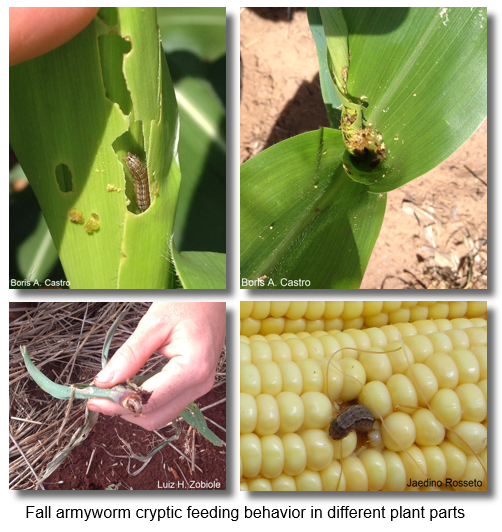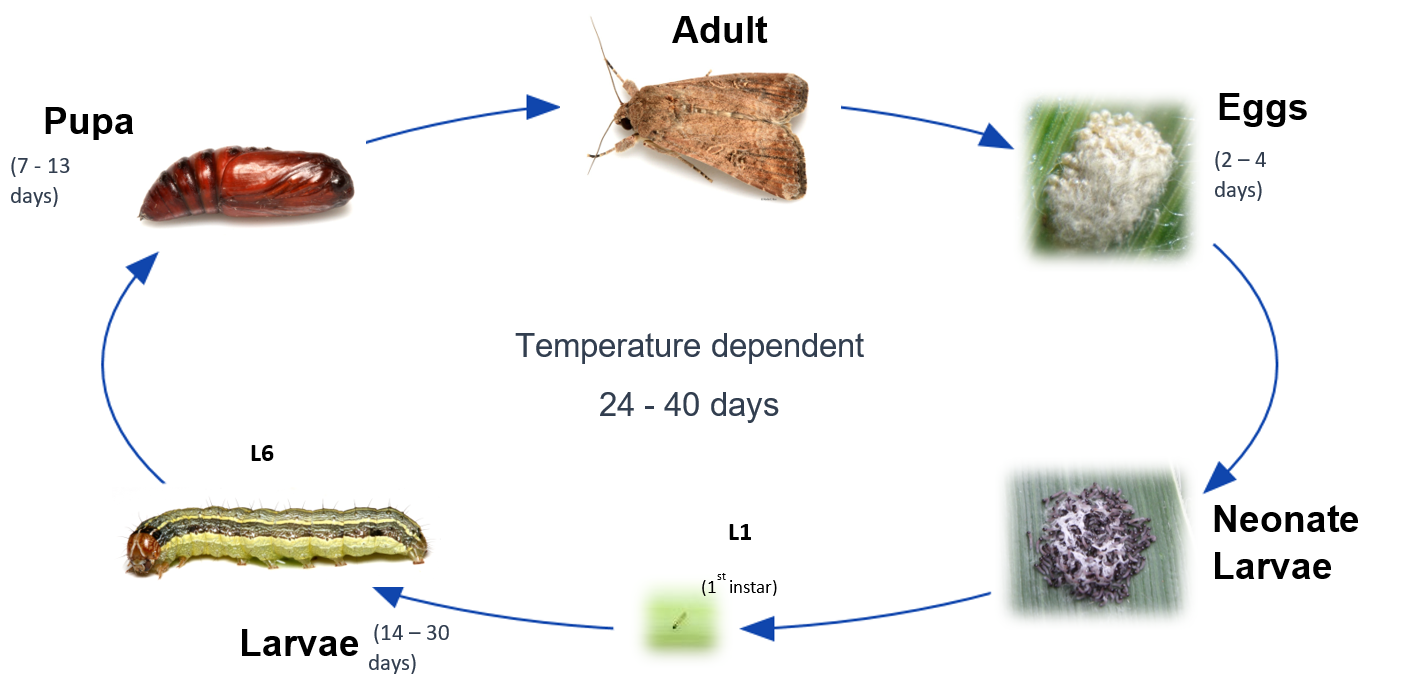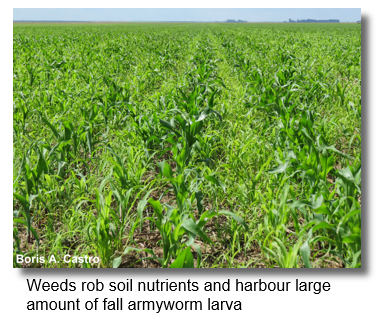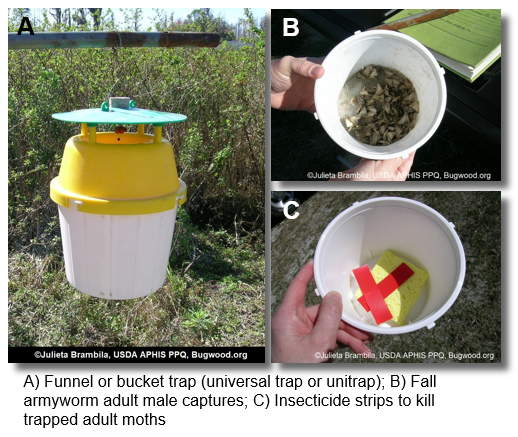
Fall Armyworm
The fall armyworm, Spodoptera frugiperda, is one of the most devastating agricultural insect pests in the world.
The Fall armyworm (FAW), has been reported to attack over 350 commercial and non-commercial plant hosts from at least 76 families. Target crops include maize (corn), sorghum, rice, wheat, cotton, millet, fodder crops and pasture species, as well as vegetable crops such as potatoes. It affects the economy and agricultural trade of entire regions and is a threat to food security for millions.
FAW was first detected in far north Queensland in January 2020. Since then, the pest has been detected in the Northern Territory, New South Wales, Victoria and Western Australia. Eradication of FAW has been determined to be unfeasible and the pest is now considered established in Australia. FAW has now been classified as an endemic pest.
Overview
1. Impact to the industry
The larval stage of the fall armyworm (FAW) is a pest that can damage and destroy a wide variety of crops causing large economic loss. Outbreaks usually occur during the early part of the summer. The FAW's larval stage is the most damaging. During this time, the larvae’s aggressive feeding behaviour can cause extensive defoliation of the host crop, and significant damage to the plant’s reproductive parts. This has direct consequences for the crop’s productivity, and can result in large economic loss in a wide variety of crops.
FAW larvae primarily target the leaf whorl, before moving to the more developed leaf tissue. Destruction of crops can happen almost overnight, because the first stages of a larva’s life require very little food, and the later stages require about 50 times more. Because of this rapid change in food consumption, the presence of larva will not be noticed until they have destroyed almost everything in as little as a night.
Key Facts
• It occurs in two races: a ‘rice strain’ (R strain) and a ‘corn strain’ (C strain).
• While both strains have been detected in Africa and Asia, work is currently underway to determine which strain is present in Australia.
2. Why is fall armyworm so devastating?
Key pest status – FAW is a serious threat to agricultural production. Studies have shown FAW can cause yield losses of up to 100% in the absence of control measures. It is estimated FAW causes billions of dollars' worth of damage across the globe every year.
Highly polyphagous – FAW has been reported to attack over 350 commercial and non-commercial plant hosts from at least 76 families. Target crops include maize (corn), sorghum, rice, wheat, cotton, millet, fodder crops and pasture species, as well as many fruit and vegetable crops.
High reproductive rate – One female moth is capable of producing 2000 eggs in its lifetime. Eggs are laid in masses of up to 200, typically on the undersides of leaves.
High migratory capacity – Adult moths are able to travel 100km per night. In its native regions of the Americas, FAW moths have been reported to travel up to 1600km when assisted by strong winds. Female moths typically migrate early in the adult stage, prior to reproduction. Many caterpillars may be present on one plant. If over-crowding occurs, they will disperse en masse in search of food.
Year-round persistence - Most active in warm, humid weather, FAW exhibits a longer window of activity in tropical climates, with some regions conducive to year-round survival. In the right conditions, FAW can have eight to 10 generations per year and a lack of diapause, allowing the pest to infest crops at any time of year. In cooler regions, only one or two generations develop; at lower temperatures, activity and development cease, and when freezing occurs, all stages are usually killed.
Cryptic feeding and behaviour – Adults hide during the daytime; ground migrating larvae may hide under crop cover; larvae feed deep in the whorl. These behaviours allow this pest to go undetected, avoid predation and make it difficult to reach with foliar sprays.
Multiple feeding behaviours – FAW larvae feed on most above-ground parts of the plant. Young caterpillars feed on leaves, creating pinholes and windows in leaf tissue, and giving leaf margins a tattered appearance. Mature caterpillars can cause extensive defoliation and damage, grazing on leaves, stems and trunk, and tunneling in to feed on fruit.
Difficult to control – In addition to FAW's behaviour making it hard to control through chemical methods, the pest has been found to have natural levels of tolerance to some insecticidal proteins. It also has a demonstrated ability to develop resistance to insecticides and transgenic traits. Resistance to carbamates (Group 1A), organophosphates (Group 1B) and pyrethroids (Group 3A) is common.
Transboundary pest – Detected in more than 90 countries, FAW is capable of dispersing further via commercial trade and its strong migratory flight behaviour.
Biology & Identification
Life Cycle
Identification of FAW throughout the life cycle
The larva is the damaging stage of the FAW. The larval cycle lasts approximately 14 days in warmer temperatures and about 30 days in milder or cooler conditions. The larva undergoes six growth stages, known as instars, which are identified as L1 up to L6.
Learning to locate and identify FAW at all stages of its life cycle is a valued skill in the scouting process and will enable you to take appropriate actions.
Eggs

- 1.5mm in newly eclosed L1 (neonates) to about 6-9mm at L3.
- Pronounced hairs and bumps along the body. Body colours of pale green and yellowish are common in L1-L2, which help them camouflage in green vegetation.
- As the larva grows, it takes on a grayish-brown to dark brown colouration. Head colour varies from orange to brown.
- Colour variation and the small size of young larvae make it difficult to differentiate from other species in the larval stage. Seeing the distinctive markings often requires a hand lens.
- Eggs are laid in clusters of up to 200.
- Egg masses are covered with a protective layer of whitish hairs.
- Egg masses are typically deposited on the undersides of leaves, next to the stalk. Under heavy population pressure, eggs may be deposited on the upper side of leaves and stems. In maize, eggs are rarely laid on silks.
- Individual eggs are dome-shaped, 0.3mm tall and 0.4mm wide. New eggs are greenish, turning cream-coloured, brown and almost black as they mature. Eggs hatch in 2-4 days under normal warm conditions.
Learning to locate and identify egg masses and their colour is a valued skill in the scouting process to predict larval eclosion and take appropriate actions.
Young larvae - growth stage L1, L2 & L3

Description:
•1½ mm in newly eclosed L1 (neonates) to about 6-9 mm at L3.
•Pronounced hairs and bumps along the body, body colours of pale green and yellowish are common in L1-L2, which help them camouflage in green vegetation.
•As larva grows, it takes on grayish brown to dark brown colouration. Head colour varies from orange to dark brown.
•Colour variation and the small size of young larvae make it difficult to differentiate from other larva species. Seeing these distinctive markings often requires a hand lens.
Behaviour:
•Newly eclosed larvae wander around briefly, quickly moving to the leaf whorl where their exposure to chemical sprays is reduced.
•Neonates may disperse by wind to nearby plants by spinning silk threads, a technique called “ballooning”, allowing an infestation to spread to nearby plants.
•As larvae grows, they exhibit increasing cannibalistic behaviour.
Older larvae - growth stages L4, L5 and L6

Description:
•15 mm at L4 to about 38 to 40 mm on fully grown L6.
•Colour patterns and spots in mid to large-sized larvae easier to observe for proper identification.
•Common colour is brown. Greenish and blackish colouration are less common.
Pupae

Description:
•15 mm in length and shiny reddish brown colour.
Behaviour:
•Fully-grown caterpillars normally drop or crawl down the plant to the ground to pupate. Occasionally, they may pupate in plant parts, especially after ear tissue feeding.
•Larvae burrow 2 to 8 cm into the soil and spins a loose cocoon made of silk impregnated with fine soil particles and soil debris.
•Pupation lasts 8 to 9 days under optimal warm conditions.
Adult

Description:
•Medium-sized moths, 32 to 40 mm wingspan, with gray or brownish forewings and dull white hindwings.
Behaviour:
•Highly active at night, hide during the day. In maize, adults can be found hiding in between leaves or inside whorls.
•Strong nocturnal flyers, capable of long distance migration.
•Females release pheromones to attract males. Oviposition takes place two to three days after mating.
•Adults live two to three weeks.
Key Identifiable features
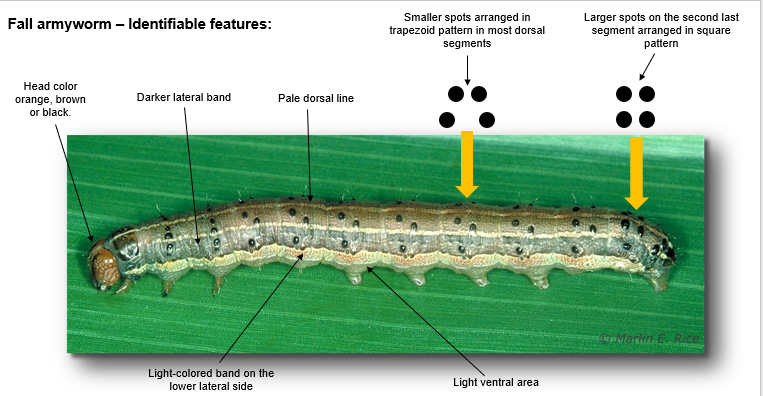
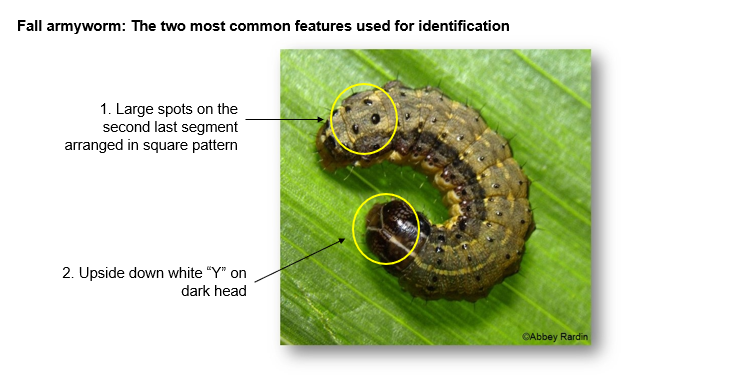
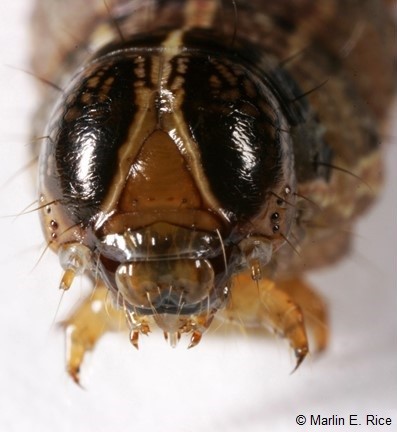
Prevention
Effective FAW management requires multiple approaches, including prevention and avoidance.
Cultural crop management
Cultural crop management is critical to enable a healthy crop, minimising plant stress and avoiding crop or field characteristics that invite FAW infestations:
- Early planting to avoid heavier pest densities in late season.
- Weed management – Eliminate weed hosts that sustain larval populations before their migration to a new crop.
- Avoid adjacent sequential planting to prevent migrations of larvae from a maturing crop to new fields.
- Avoid plant stress – Proper fertilisation, irrigation, cultivation, etc. Healthier plants tend to recover faster and recover from some yield loss.
Note: The practice of crop rotation is of limited use for FAW management due to the pest’s high mobility, migratory status and polyphagous behaviour.
Monitoring
1. Traps
Importance:
•Pheromone traps alert growers of the arrival of FAW adults to an area.
•An increase in adult FAW trapping does not trigger an insecticide application and should not be used as an action threshold. However, this information helps farmers understand when to increase field scouting.
Notes:
•There are numerous lures and trap designs for FAW. Instructions for use vary by manufacturer. It is important to standardise trapping methods when the intention is to use for community-wide forecasting.
•Adult data collected over several seasons provide an indication of when peak adult trapping is normally expected to occur in an area.
•When handling lures, wear disposable rubber gloves or wash your hands immediately. Not doing so may cause contamination of bait stations.
•Do not leave used lures or lure wrappings near traps. The small amount of lure left in them may compete with baited traps.
•Never place more than one lure at a time in a trap.
2. Field scouting
It is designed to detect FAW presence in a field and assess feeding injury:
•Field scouting is one of the most important activities a farmer can do to manage infestations based on informed decisions.
•It consists of entering the field and looking for presence of fall armyworm eggs, larvae, etc. and feeding signs.
•Relies on the ability to correctly identify FAW, understand its biology and behaviour, and recognise early feeding.
•It helps farmers understand ecological factors that favour or delay a potential infestation such as natural insect mortality, plant stressors, alternate hosts, plant phenology, etc.
•Fields should be “scouted” at a minimum of once per week or more often when conditions favour infestations, e.g. crops in the vegetative stage, increase in male moth trapping, presence of egg masses, etc.
Control
1. Biological
- The multiple life stages of FAW are affected by predators, parasites and diseases.
- Biological control encourages the conservation of natural enemies and the augmentation of natural enemy populations to maintain FAW feeding below an economic threshold level.
2. Chemical
Chemical control depends on the rational and responsible use of selected approved chemical insecticides to manage the FAW.
- Includes baits and foliar insecticides.
- The use of foliar insecticides should be based on recommended economic thresholds and the implementation of an Insecticide Resistance Management Strategy (IRMS) plan.*
- Target smaller larvae (L1, L2, L3) to prevent heavier injury caused by more difficult to control large larvae. Also targeting instar larvae before they become entrenched.
- Make foliar applications before larvae burrow deeper into the whorl in vegetative stage (or before they enter the ears in mature maize plants).
*Note: Known FAW resistance has occurred for carbamates (MoA Group 1A); organophosphates (Group 1B); pyrethroids (Group 3A); Bacillus thuringiensis and Cry1F protein (Group 11A); diamides (Group 28). An IRMS plan requires the rotation of different MoA for season management of an insect pest.
Corteva Agriscience has assisted Horticulture Innovation to successfully secure an emergency use Permit 89241 from the Australian Pesticides and Veterinary Medicines Authority (APVMA) to allow the use of Success Neo & Delgate for the control of FAW in various crops & Permit 89390 to allow the use of Success Neo for the control of FAW in maize, sorghum & millet . See SOLUTIONS section for further information.
Solutions
Corteva Agriscience offers several solutions for the control of FAW in various crops:
- Intrepid Edge - Jemvelva active and methoxyfenozide
- Success Neo and Delegate Insecticide can be applied to various crops under Permit 89241.
Downloads
Emergency permit for Success Neo and Delegate insecticides - Various crops
Emergency permit for Success Neo insecticude - Sorghum
Success Neo & Entrust Organic on FAW
Important points for effective control
Success Neo works in two ways:
- via direct contact
- via ingestion
It is important to remember that it is not systemic, this means that it does not travel through the plants vascular system, thus new untreated growth remains unprotected. It also means that grubs entrenched deep within the plant foliage are protected from the spray deposit and may not be controlled.
It is for this reason it is recommended that application of Success Neo are made early in the crops growth stage – apply during the vegetative crop stages to ensure thorough contact with the pest. Follow label directions ensuring that the correct label rate is applied with sufficient water to achieve excellent coverage and penetration into the crop canopy.
Larvae size and chemical control
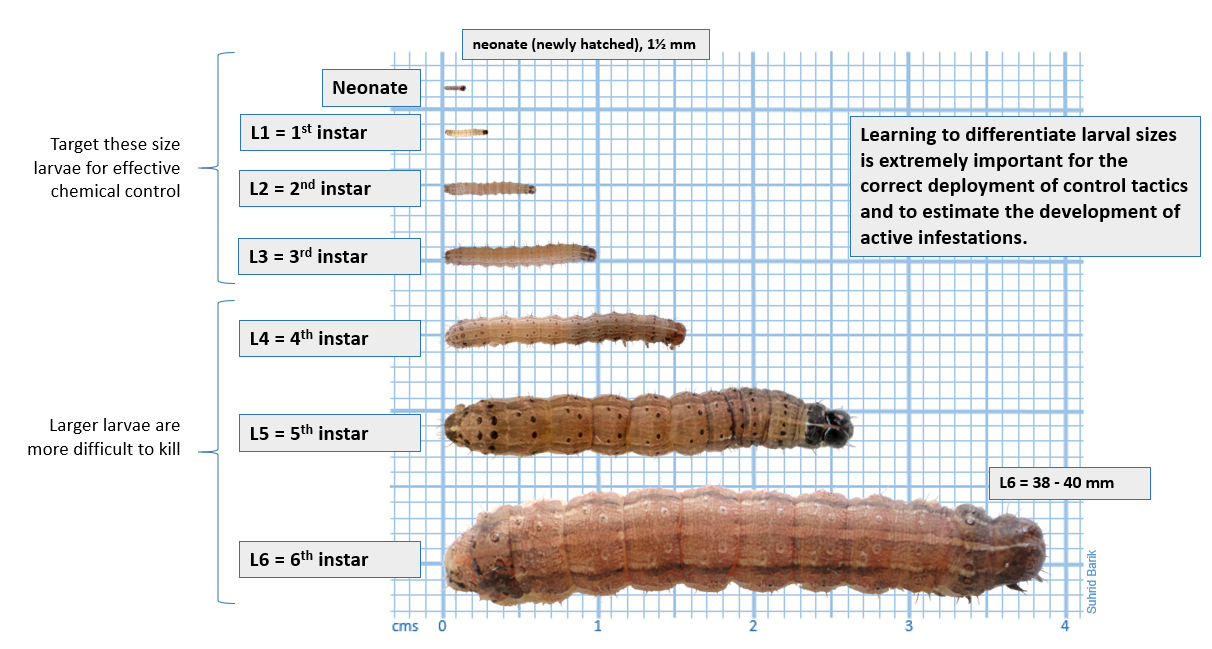
Jemvelva active rates of application
Berryfruit
| Crop | Product | Rate |
| Berryfruit | Success Neo | 40 mL/100L |
Broadacre Crops
| Crop | Product | Rate |
| Canola | Success Neo | 150 mL/ha |
| Cotton | Success Neo | 400 mL/ha |
| Forage Brassicas | Success Neo | 100 mL/ha |
| Soybean | Success Neo | 300 mL/ha |
Citrus Fruits
| Crop | Product | Rate |
| Citrus Fruits | Success Neo | 40 mL/100L |
| Citrus Fruits | Delegate | 20 g/100L |
Coffee
| Crop | Product | Rate |
| Coffee | Success Neo | 40 mL/100L |
Grapes
| Crop | Product | Rate |
| Grapes | Delegate | 10 g/100L |
Herbs & Ornamentals
| Crop | Product | Rate |
| Culinary Herbs | Success Neo | 400 mL/ha |
| Ornamentals | Success Neo | 40 mL/100L |
Maize
| Crop | Product | Rate |
| Maize | Intrepid Edge | 500 mL/ha |
Nuts
| Crop | Product | Rate |
| Macadamias | Success Neo | 40 mL/100L |
| Pistachios | Success Neo | 1 L/ha |
Pulses
| Crop | Product | Rate |
| Chickpeas | Success Neo | 200 mL/ha |
| Pulses | Success Neo | 300 mL/ha |
Stone & Pome fruit
| Crop | Product | Rate |
| Pome Fruit | Delegate | 20 g/100L |
| Stone Fruit | Delegate | 20 g/100L |
Tropical & Sub-tropical fruits
| Crop | Product | Rate |
| Bananas | Success Neo | 40 mL/100L |
| Tropical and Subtropical Fruits | Success Neo | 40 mL/100L |
| Avocado | Success Neo | 40 mL/100L |
| Mango | Success Neo | 40mL/100L |
| Kiwifruit | Success Neo | 40mL/100L |
| inedible peel | Success Neo | 40mL/100L |
Vegetables
| Crop | Product | Rate |
| Sweet Corn | Success Neo | 400 mL/ha |
| Brassica Vegetables | Success Neo | 400 mL/ha |
| Leafy Vegetables | Success Neo | 400 mL/ha |
| Cucurbits | Success Neo | 400 mL/ha |
| Fruiting Vegetables | Success Neo | 400 mL/ha |
| Legume Vegetables | Success Neo | 400 mL/ha |
| Stalk & Stem Vegetables | Success Neo | 400 mL/ha |
| Root & Tuber Vegetables | Success Neo | 400 mL/ha |
